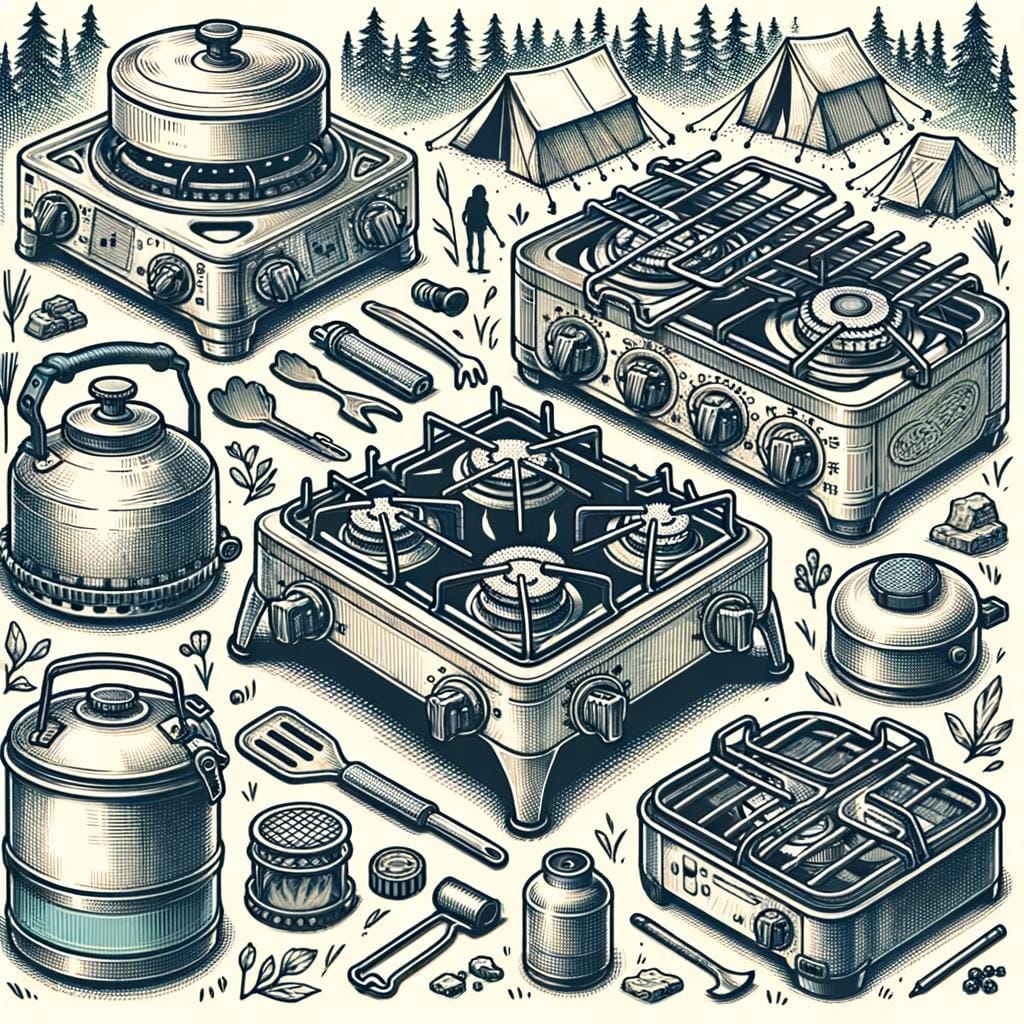Portable stoves have become an essential companion for outdoor enthusiasts engaging in activities like camping, hiking, and tailgating. These compact and convenient cooking devices offer the flexibility to prepare meals on the go, regardless of location. Whether it’s boiling water for a cup of coffee at a campsite or grilling up some burgers during a tailgating event, portable stoves provide the means to cook delicious food outdoors efficiently.
When it comes to portable stoves, there is a diverse range of options available in the market to suit different needs and preferences. From gas stoves to propane stoves and alcohol stoves, each type offers unique features that cater to specific cooking requirements. The versatility of these portable stoves allows outdoor enthusiasts to choose the one that best fits their lifestyle and activities.
One of the key advantages of using portable stoves is their quick cooking times, fuel efficiency, and compact size for easy transportation. These features make them an ideal choice for individuals who value convenience and practicality when preparing meals outdoors. Furthermore, portable stoves are designed to be lightweight and easy to set up, making them a popular choice among outdoor enthusiasts looking for hassle-free cooking solutions on their adventures.
Types of Portable Stoves
Portable stoves come in various types, each suited for different needs and preferences. Gas stoves are popular among outdoor enthusiasts due to their convenience and ease of use. These stoves typically use butane or propane gas canisters as their fuel source, providing a reliable cooking option while camping or hiking. Gas stoves are known for their quick cooking times and ability to maintain a consistent flame even in windy conditions, making them a favorite choice for many outdoor adventurers.
Propane stoves, on the other hand, offer a high heat output and are commonly used for more demanding cooking requirements. These stoves are often larger in size compared to gas stoves but provide excellent performance when cooking meals that require more intense heat. Propane stoves are ideal for preparing large feasts during camping trips or tailgating events, where a portable yet powerful cooking solution is needed.
Alcohol stoves have gained popularity among minimalist campers and backpackers due to their lightweight design and simplicity. These stoves typically use denatured alcohol as fuel, which is readily available in most outdoor stores.
Alcohol stoves are compact, easy to transport, and offer a cost-effective solution for those looking to cook simple meals while on the go. While they may not provide the same level of heat output as gas or propane stoves, alcohol stoves excel in being environmentally friendly and low-maintenance options for outdoor cooking adventures.
Benefits of Using Portable Stoves
Portable stoves have become an essential and popular choice for outdoor enthusiasts due to their numerous benefits. One of the significant advantages of using portable stoves is their quick cooking times. Whether you are camping, hiking, or tailgating, these stoves offer the convenience of preparing meals rapidly, allowing you to spend more time enjoying your outdoor activities. With powerful burners that can heat up quickly, portable stoves make cooking on-the-go efficient and hassle-free.
Another key benefit of portable stoves is their fuel efficiency. Many models are designed to optimize fuel usage, ensuring that you can cook multiple meals without constantly refilling or changing fuel sources. This not only saves you money on fuel costs but also reduces the environmental impact of your outdoor adventures.
Additionally, the compact size of portable stoves makes them easy to transport and store. Their lightweight construction and foldable designs make them ideal for backpacking or traveling to remote locations where space is limited.
Furthermore, portable stoves offer versatility in cooking options. Whether you prefer gas stoves, propane stoves, or alcohol stoves, there is a wide range of choices available in the market to suit your needs. You can select a stove based on your cooking preferences, such as simmering, boiling, or grilling.
With adjustable heat settings and stable platforms for pots and pans, portable stoves provide the flexibility to cook various types of dishes outdoors. Overall, the benefits of using portable stoves make them a convenient and practical solution for anyone who loves outdoor activities and delicious homemade meals on-the-go.
How to Choose the Right Portable Stove
When it comes to choosing the right portable stove for your outdoor adventures, there are several key factors to keep in mind. The following tips will help you narrow down your options and find the perfect portable stove that suits your needs:
- Size: Consider how many people you will be cooking for and the amount of food you need to prepare. If you’re camping solo or with a partner, a smaller, more compact stove may suffice. However, larger groups may require a stove with multiple burners for efficient cooking.
- Weight: If you plan on backpacking or hiking to your campsite, the weight of the portable stove is crucial. Look for lightweight stoves made from durable materials that won’t weigh you down during your outdoor excursions.
- Fuel Type: Portable stoves commonly use propane, butane, alcohol, or wood as fuel sources. Consider the availability of fuel types in your camping area and choose a stove that aligns with your preferences and needs.
- Cooking Power: The BTU (British Thermal Unit) output of a stove determines its cooking power. Higher BTU ratings mean faster cooking times, which can be beneficial if you need to prepare meals quickly while on the go.
By carefully considering these factors, you can make an informed decision when selecting a portable stove that meets your requirements and enhances your outdoor cooking experience. Whether you prioritize portability, efficiency, or versatility in your camping gear, choosing the right portable stove is essential for enjoying delicious meals while exploring the great outdoors.
Remember to compare different models based on size, weight, fuel type, and cooking power to find a portable stove that ticks all the boxes for your next adventure.
Portable Stove Safety Tips
Portable stoves are a popular choice for outdoor activities like camping, hiking, and tailgating due to their convenience and practicality. These compact cooking devices allow outdoor enthusiasts to prepare hot meals on the go, making it easier to enjoy delicious food even in remote locations. However, it is essential to follow safety measures when using portable stoves to prevent accidents and ensure a safe cooking experience.
One of the most crucial safety tips when using portable stoves is proper fuel handling. It is essential to use the recommended fuel type for your specific stove model and avoid mixing different types of fuels. Always store fuel containers away from heat sources and open flames, and never refill a hot stove or near an open flame. Additionally, make sure to check for any leaks in the fuel line before igniting the stove to prevent potential hazards.
Ventilation is another critical aspect of using portable stoves safely. Cooking indoors or in poorly ventilated areas can lead to carbon monoxide buildup, which can be extremely dangerous.
Always use your portable stove in well-ventilated spaces, such as outdoors or with windows open, to allow proper airflow and reduce the risk of carbon monoxide poisoning. It is also essential to never leave a burning stove unattended and always keep an eye on the flame to prevent accidental fires or burns.
Portable Stove Recipes
Portable stoves are a fantastic addition to any outdoor adventure, making it easy to whip up delicious meals even in remote locations. One-pot meals are a popular choice among campers and hikers due to their simplicity and minimal cleanup.
A hearty stew or chili can be easily prepared by simmering ingredients like beans, vegetables, and protein over a portable stove. Simply add all the ingredients into a pot, adjust the heat on the stove, and let it cook until flavors meld together for a comforting meal.
Grilled sandwiches are another favorite when it comes to portable stove recipes. Whether you prefer classic grilled cheese or more gourmet options with various fillings, a portable stove can easily mimic the results of a traditional grill. Simply butter the bread, add your desired fillings like cheese, meat, or veggies, and grill each side until golden brown and melty. The versatility of portable stoves allows for endless variations to suit everyone’s taste buds.
For those with a sweet tooth, skillet desserts cooked over a portable stove are sure to satisfy cravings while enjoying the great outdoors. Classics like s’mores dip or apple crisp can be easily made in a small skillet over gentle heat from the portable stove’s flame. These desserts not only provide a sweet treat but also create a cozy ambiance around the campfire, perfect for ending a day of outdoor activities on a delicious note.
| Portable Stove Recipe | Ingredients | Instructions |
|---|---|---|
| One-Pot Chili | Ground beef or turkey, beans, tomatoes, onions, bell peppers, chili powder | Add all ingredients to pot on medium heat and simmer until meat is cooked through and flavors blend. |
| Gourmet Grilled Cheese | Bread slices, cheddar cheese, bacon slices, tomato slices | Butter two bread slices on one side each; place one slice in skillet butter side down; add cheese and other toppings; top with remaining slice (butter side up); grill both sides until golden brown. |
Maintenance and Care of Portable Stoves
In conclusion, portable stoves have become essential tools for outdoor enthusiasts engaging in activities such as camping, hiking, and tailgating. The convenience and practicality of these portable cooking devices cannot be overstated, as they offer quick cooking times, fuel efficiency, and compact sizes for easy transportation. By choosing the right type of portable stove based on size, weight, fuel type, and cooking power, users can enhance their outdoor culinary experience significantly.
Moreover, ensuring the safety of using portable stoves is crucial to prevent accidents or mishaps. Following proper fuel handling procedures, maintaining good ventilation while cooking, and implementing fire prevention measures are key aspects that users need to keep in mind at all times. By adhering to these safety tips and guidelines, outdoor enthusiasts can enjoy their portable stoves with peace of mind.
Furthermore, taking care of portable stoves through regular cleaning, proper storage practices, and maintenance routines is vital to ensure their longevity and optimal performance. By following the recommended maintenance procedures outlined in this article diligently, users can extend the life of their portable stoves and continue experiencing hassle-free outdoor cooking adventures for years to come. Overall, incorporating portable stoves into your outdoor activities can elevate your culinary experience and make your adventures even more enjoyable.
Frequently Asked Questions
What Portable Stoves Can Be Used Indoors?
Portable stoves that can be used indoors are typically electric or butane stoves. Electric stoves are safe for indoor use since they don’t emit any harmful fumes, while butane stoves should only be used in well-ventilated areas to prevent carbon monoxide buildup.
Are Portable Stoves Safe?
Portable stoves can be safe when used properly and according to the manufacturer’s instructions. It’s important to keep flammable items away from the stove, never leave it unattended while cooking, and always ensure proper ventilation if using a gas stove indoors.
Which Portable Gas Stove Is Best?
The best portable gas stove depends on individual needs and preferences. Some popular options include the Coleman Butane Stove, Camp Chef Everest High-Output 2-Burner Stove, and GasOne Dual Fuel Portable Stove. Consider factors like size, power output, fuel efficiency, and reliability when choosing the best portable gas stove for your needs.

An avid outdoor enthusiast, writer, and environmental advocate who has spent over two decades exploring the world’s most breathtaking landscapes. With a background in environmental science and a passion for adventure, Frances combines her love for nature with her talent for storytelling to inspire others to embark on their own outdoor journeys.


